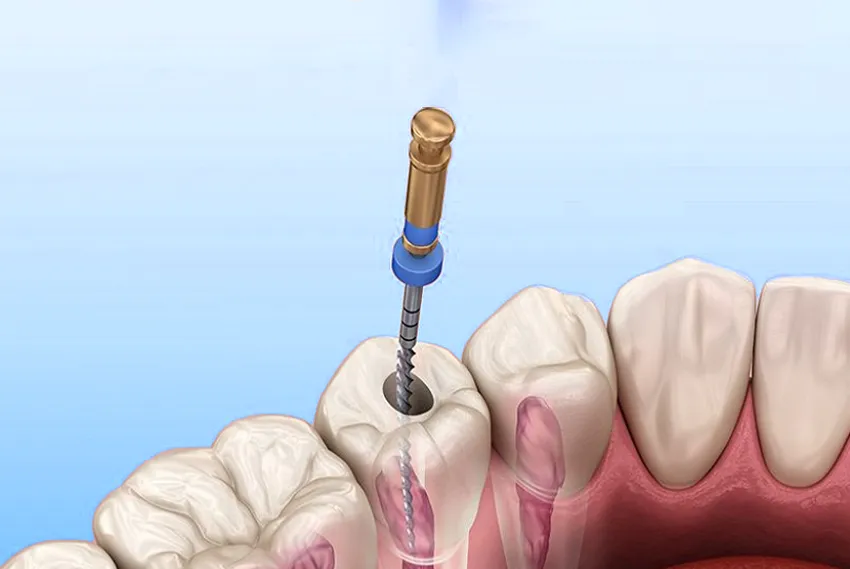How is dental denervation ? All of us will face this case sooner or later during our life, so it is better to know basic information and tips about this type of treatment and health. root canal treatment dubai is translated as: Root canal therapy (in English: Endodontic therapy) or root canal therapy, which is sometimes called “root canal” in Persian.
How is dental denervation
In fact, root canal treatment is a dental treatment in the endodontic branch (nerve removal is called endo for short), which is performed to treat the infection of the tooth core.
How is dental denervation
In order to better understand denervation, you must first familiarize yourself with the structure of the tooth.
tooth structure
The tooth consists of two parts, the crown and the root. The crown is the white cap that you see in the mouth and you know it as a tooth, and the root is the part of the tooth under the crown that is inserted into the gums and jawbone to keep the crown fixed.
How is dental denervation
All teeth have three main layers:
How is dental denervation
- From the outside to the inside, there is the enamel layer, which is white and completely surrounds the tooth to protect the vulnerable parts inside the tooth. Enamel is the hardest substance in the human body.
How is dental denervation
- Ivory is the layer under the enamel, which is yellow in color. In places where the enamel has been lost, you can see the crown of the tooth, especially in those who grind their teeth and grind their teeth together, dentin may be visible on the biting surface of their teeth. Ivory is softer and more vulnerable than enamel.
How is dental denervation
- The pulp is the core of the tooth, which is home to the dental nerve and blood vessels that nourish the tooth. The pulp is the only living part of the tooth. When the pulp of our teeth gets infected, it must be completely drained and cleaned and filled with special materials. We call this nerve removal.
How is dental denervation
When is there a need for tooth denervation ?
Nerve removal is performed in cases where the pulp has been irreversibly damaged and there is no other choice but to empty and clean it and fill it with special fillers. The cause of pulp damage is usually one of the following:
How is dental denervation
- Breaking a tooth during an accident such as an accident, falling, or playing.
- Deep tooth decay that has not been treated and has reached the pulp.
- Leaking old or improper fillings that have caused decay to occur underneath.
If you experience any symptoms such as toothache or swollen gums or anything else that is unusual, see your dentist to check the condition of your teeth. Also, visit the dentist regularly to check the old tooth fillings so that if they are separated from the tooth or cracked, they should be replaced as soon as possible.
How is dental denervation
The symptoms of dental pulp infection are as follows:
How is dental denervation
- Pain when eating or drinking, especially when the temperature is very cold or hot.
How is dental denervation
- Pain when chewing.
How is dental denervation
- loose teeth
How is dental denervation
If the toothache goes away, does that mean I don’t need a nerve denervation?
Note that as the infection progresses, these symptoms may disappear because the pulp is destroyed and the nerves no longer send messages. You may think your tooth is healed, but the infection has actually spread. Finally, the following symptoms may appear:
How is dental denervation
- Return of pain when chewing
How is dental denervation
- Swelling of the gums around the affected tooth
How is dental denervation
- Purulent discharge from the teeth
How is dental denervation
- facial swelling
How is dental denervation
- Darkening of tooth color
How is dental denervation
Note that if you have a toothache, you must check it. An infected tooth will not heal on its own. If you leave the tooth alone, its condition worsens and the adjacent teeth and bone are also at risk. If the infection is widespread, the chance of success of dental denervation treatment decreases.
How is dental denervation
Tooth denervation steps
To treat a dental pulp infection, bacteria and damaged tissue must be removed. If you don’t reach the tooth in time, you will have to pull the tooth. Since artificial prostheses that replace teeth have many problems and constantly cost you money, it is better to preserve your natural teeth as much as you can.
How is dental denervation
- For nerve extraction, the mouth is first numbed.
- The dentist then makes a hole in the crown of the tooth to access the pulp.
- With the help of special dental tools such as drill and file, the entire pulp chamber is emptied and removed.
- The walls of the pulp chamber and the root, especially the tip of the root, must be completely shaved and cleaned.
- After the tooth core is completely cleaned, it is time to fill it. With special filling materials, the dentist carefully fills the entire pulp and finally seals the tooth so that there is no way for bacteria to penetrate.
- Finally, usually the tooth should be covered. The veneer is the artificial crown that is placed on the tooth and surrounds it. In this way, there is no more pressure on the actual crown of the tooth and the risk of breaking it is reduced.
Why sometimes denervated teeth need to be treated again?
How is dental denervation
It is possible that the tooth will not heal as expected and will need retreatment despite the initial treatment. The reasons for the failure of nerve removal can be one of the following:
How is dental denervation
- The narrowness or curvature of the tooth root canal has caused part of it not to be properly cleaned and treated in the initial denervation.
- The complexity of the anatomical structure, such as the sub-branches of the root canal, has not been identified in the initial treatment.
- Connecting the crown or other restoration on the tooth, after denervation is not done in time and is delayed.
- The restoration of the denervated tooth could not prevent the infection of the inside of the tooth with oral saliva, as a result, the infection has started again.
Also, for the following reasons, a tooth that has been successfully denervated may have problems again:
- Create new caries
- Breaking, cracking, or loosening of the tooth cover or filling (which was supposed to prevent the penetration of foreign substances, but can no longer)
- breaking teeth
In this figure, the canal of the root of the tooth is shown. In the picture below, you can see that the root of the tooth has a secondary canal that may not be seen during nerve extraction and may not be treated. As a result, denervation treatment fails.
What is the secondary root canal?
The accessory canal is a part of the complex anatomy of the tooth canal that may be overlooked by the dentist during root canal treatment.
The root system of the tooth, which contains fine vessels, nerves and connective tissues, is very complex and precise. This root system, like the roots of plants, may have small branches that separate from the main channel.
These different root branches are usually located in the areas where the roots of multi-rooted teeth join together or are located around the distal third of the root, however, they may exist anywhere else along the main root canal.
Sometimes it is very difficult to identify the root canal and to clean and fill it. If a tissue remains inside one of them, it can be the source of re-infection. Therefore, the diagnosis and treatment of the root canal is very important in denervation.
Frequently asked questions about denervation and endodontic treatment
Does denervation hurt?
Although nerve rooting may seem scary, the experience is similar to a deep filling. You will not feel pain during nerve extraction because you are under the influence of anesthesia. You will also be given painkillers to take if needed. This pain is controlled with common pain relievers such as acetaminophen or ibuprofen.
You may be given antibiotics to kill bacteria before the procedure.
According to a review of 72 other studies conducted on patients who underwent denervation, it was found that the pain before the treatment was high in these people, but within a day after the treatment, it decreased to an average level and within a week After the treatment, it significantly subsided and became minimal.
Can a tooth be extracted during pregnancy?
If you are pregnant, it is recommended not to do any elective treatments (such as cosmetic dental treatments) but necessary dental treatments should be done. Nerve removal is a treatment that should not be postponed at any stage of pregnancy. However, due to the need for X-rays, it is recommended to do this in the second trimester of pregnancy.
Is it possible to take care of dental problems during quarantine (due to corona disease)?
For essential dental treatments, you must see a dentist as soon as possible. Among the things that need to be referred are:
- Swelling of the gums, cheek, or face that has spread to the neck, eyes, or floor of the mouth.
- Severe pain that makes you lose sleep or concentration.
- A mouth ulcer that has not healed after two weeks.
- Bleeding more than 20 minutes after tooth extraction that does not stop even with firm pressure of the jaw on the dressing.
- A broken tooth that caused pain or possible injury to the cheek or tongue.
- Tooth extraction
- Bleeding due to facial injury
What is the difference between denervation of front teeth and wisdom teeth or large molars?
For nerve extraction, a hole must be made in the crown of the tooth so that the dentist can access the pulp. For the front teeth, this hole is often created on the back surface of the tooth, but for the back teeth, the hole is usually created on their upper surface, that is, the surface of the tooth with which we chew food.
After the work is finished, the hole created for the front teeth is closed with tooth filling material. Temporary materials are usually used until the crown is prepared and attached to the tooth. However, sometimes veneers are not necessary for the front teeth because there is not much pressure on these teeth. But for back teeth that are under a lot of pressure, a crown is often needed to prevent the tooth from breaking and chipping.
In order to cover the front tooth that has been denervated, care must be taken in the beauty of the restoration, because its color difference with other teeth can affect the beauty of the smile. Even when the veneer is chosen exactly the same color as the adjacent teeth, due to the gradual color change of the other teeth and the resistance of the veneers to color change, a color difference may be created over time. In this case, this problem can be solved by whitening the teeth.
Another important difference in the difference between the innervation of front and back teeth is the number of their roots. Front teeth have fewer roots (usually one root containing a root canal). Usually, small molars or premolars and back teeth have two or three roots, each containing one or two root canals. The more roots there are, the longer the denervation treatment will be. The treatment may not be completed in one session and several sessions may be required to complete the treatment.
How is tooth extraction done at home?
Tooth extraction at home is a natural method that is performed at home to relieve pain and tooth root infection. This method is temporary and relieves the infection of the root of the tooth to some extent, you must visit the dentist as soon as possible.
Here are some ways to relieve nerve pain:
- In these cases, you can use a cold water compress. When your tooth becomes inflamed and infected, you can reduce the pain and inflammation of your tooth by using ice or ice packs.
- Turmeric is another thing that reduces inflammation and toothache because turmeric has strong anti-inflammatory properties. You should mix turmeric with a small amount of water to make a paste, then dip a cotton ball in it and place it on the gum of the part that hurts. You should do this 3-4 times a day to reduce the inflammation and pain of your tooth.
- Using tea tree oil can also reduce tooth nerve pain. You can pour a few drops of this oil on the part that hurts and massage it or mix it with water and swirl it in your mouth. Do this 3 to 4 times.
- Using salt water is one of the famous ways of toothache. Salt water has antiseptic properties and reduces tooth root infection. You should also do this 3 to 4 times a day.
How long does a denervated tooth last?
In the treatment of tooth extraction due to tooth decay and root infection, the pulp of the tooth is removed and its interior is filled with materials. Because this tooth is damaged, it is weaker than other healthy teeth, therefore, no matter how much it is treated, it still has a shorter life than other teeth. About a denervated tooth lives 10 to 15 years. Of course, you can increase its durability by using dental veneers or other methods.











